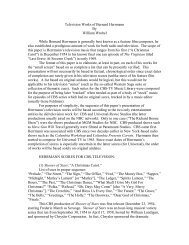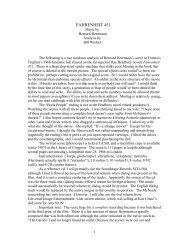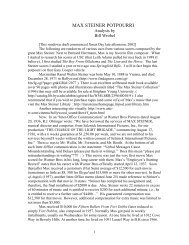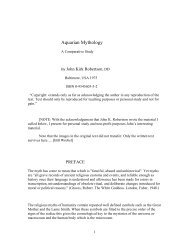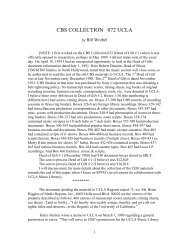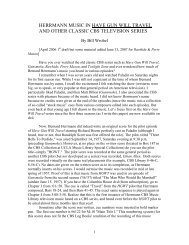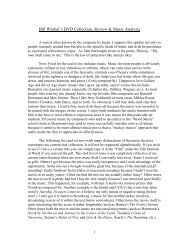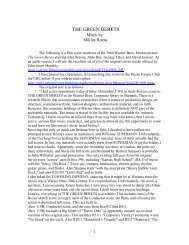Valentine's Day, Sunday, February 14, 2010 at 10:20 am
Valentine's Day, Sunday, February 14, 2010 at 10:20 am
Valentine's Day, Sunday, February 14, 2010 at 10:20 am
- No tags were found...
Create successful ePaper yourself
Turn your PDF publications into a flip-book with our unique Google optimized e-Paper software.
whole notes D/G held ferm<strong>at</strong>a. Bass clarinet/Fags/horns/tuba/VC/CB play note G. Vibeand Pos play note B. Total sound is th<strong>at</strong> of G major (notes G/B/D). About half of theviolins and violas play along with the women's chorus with notes C/B/A/B bowedtremolo.Bars 13-<strong>20</strong> = Scene: The Lady appears within the cloud, and the two frightenedgirls run a few yards away, backs turned. Francisco sees nothing and asks wh<strong>at</strong> is wrong.Very effective scene and very moving music!Focusing on the prominent women's chorus th<strong>at</strong> plays triad whole notes, we starton Bar 13 with the C major triad (notes C/E/G). Below is a list of the religioso chordsthrough Bar <strong>20</strong>. The revised Reel 2/3 ends on Bar 18.Bar 13 = C major (notes C/E/G)Bar <strong>14</strong> = A minor 1st inversion (notes C/E/A)Bar 15 = D major (notes D/F#/A)Bar 16 = B minor 1st inversion (notes D/F#/B)Bar 17 = E major (notes E/G#/B)Bar 18 = C# minor 1st inversion (notes C#/E/G#).Bar 19 = Eb major 2nd inversion (notes Bb/Eb/G)Bar <strong>20</strong> = C minor (notes C/Eb/G)In Bar 13 the harp beautifully plays rising leg<strong>at</strong>o 16th notes starting with C. Sonotes C/G/C/E, G/(back down to previous) C/E/G, middle C/(back down to) E/G/C,E/(back down to) G/C/E. The gong and cymbal are tremolo. The vibe plays the exacts<strong>am</strong>e chords as the women's chorus. The organ in Bar 13 plays notes C/G/C/E (bottomstave), G/C/E/G (top stave) with pedal. The piano plays whole notes C/G/E,C/E/G/C. Violins play notes G/C/E/G. Violas plays dyad notes C/E; VC on C/G; CB onC(c). Pos play C major root position (notes C/E/G). Clarinets and trumpets sound the Cmajor 1st inversion (notes E/G/C). Two horns are unison on note G tied to next bar.Bassoons play G, contra-bassoon on C. Bass clarinet sounds the C note. Oboes play C(c'''); flutes on notes E/G.Bar <strong>14</strong> = The harp plays leg<strong>at</strong>o rising 16th notes A/E/A/C, etc.Bar 19 = The original Reel 2 pt 3 cue comes into effect again as the Lady nowspeaks, "Don't be afraid. I won't hurt you." The oboe d'<strong>am</strong>ore is introduced as the soloprominent instrument--quite a rarity in present day scoring. It sounds sweeter or lessbiting than the standard oboe. It is a minor third lower than concert "C" pitch. So awritten C would sound as note A; written note Eb would sound as C, and so on. After aquarter rest, the instrument plays mf "dolce" quarter note Bb [written Db] up to half noteEb [written Gb] as the fading chorus play the Eb major chord (notes Eb/G/Bb). Theviolins are fingered tremolo half notes. Violas and celli (VC) are bowed trem on Eb halfdottednote to D quarter note. One half of them play ponticello (bowing near the bridgecre<strong>at</strong>ing a r<strong>at</strong>her nasal tone). Flutes play the Eb 1st inversion triad (notes G/Ab/Eb). Etc.Bars 26-33 = The cue changes to "Andantino simplice" in 6/8 time. Here the Ladysays, "I <strong>am</strong> from Heaven..." The music is from "Tis the Month of OurMother"[unknown] arranged by Max. The flutes and clarinets are soli, playing dyadnotes. So E/G# quarter notes to E/G# 8th, to 8th note triplet E-G#/D#-F#/E-G to (Bar 27)G#/B quarter note to F#/C# 8th to G#/B quarter notes, etc. The harp and celeste play thisp<strong>at</strong>tern in a chordal fashion, starting with E major (notes E/G#/B) or actual treblenotes E/G#/B/E/G# played wavy gliss. 6 violins play note B (b’’’) half-dotted note tied49




